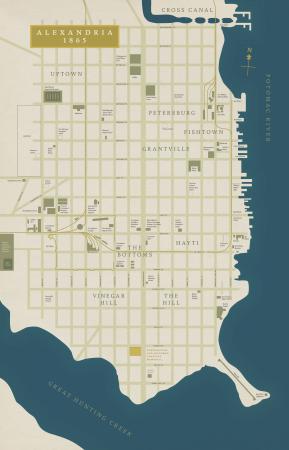A Community of Contrabands and Freedmen
Community
It affords me great pleasure to bear testimony to the good conduct of our colored fellow citizens for the last two years. In this city [Alexandria] we have had eight to ten thousand contrabands, or refugees from Virginia slavery;… Their sobriety, industry, and economy have far exceeded my expectations….[i]
Judge John C. Underwood, Letter to William Syphax, July 12, 1865

Source: Howard+Revis Design Services, Washington, D.C. and Alexandria Black History Museum.
The confusion and disruption wrought by the Civil War in the South allowed for enslaved people, particularly in northern parts of Virginia, to seek freedom in Alexandria in territory controlled by the Union Army. Arriving in a city that had seen the flight of many Confederate sympathizers, the self-emancipated refugees came under the protection of the federal government. They joined a multifaceted African American community of free and enslaved people established in the 100-plus years since Alexandria’s founding in 1749.
In the beginning, the sheer number of freedom-seekers overwhelmed the system. They arrived exhausted, malnourished, weak, and sometimes sick, many in conditions that proved fatal.[ii] The humanitarian crisis, like that facing refugees in our own time, grew out of a lack of food and adequate housing, and contagious diseases spread throughout the city. Nevertheless, as the war years progressed, conditions improved:
- The status of the self-emancipated refugees changed from Contrabands (a term that still implied status as property) to freedpeople.
- African American men earned the right to defend their country and fight for their freedom.
- U.S. policy mandated that salaries be paid to formerly enslaved individuals employed by the government.
- Hospitals were established for treatment of African American civilians and soldiers.
- With support from abolitionist organizations in the North, aid workers arrived and helped to ease the crisis.
Under the umbrella of the military government, a community emerged as the freedom-seekers began to build productive lives for themselves. They worked in numerous capacities to aid the Union war effort, from construction workers to longshoremen to nurses and domestics. They built homes and established churches and schools. New African American neighborhoods sprang up across the city, joining the older free Black neighborhoods that were already present.
Footnotes
[i]Judge John C. Underwood to William Syphax, Letter, 12 July 1865, reprinted in Alexandria Gazette, 18 July 1865, 2. William Syphax was a free Black who became Chief Messenger of the Department of the Interior. His family was enslaved at Robert E. Lee’s Arlington House.
[ii] Testimony of Captain John C. Wyman, “An Official Inquiry into the Conduct of The Reverend Albert Gladwin, Superintendent of Contraband at Alexandria, Virginia,” archived in Office of the Adjutant General Colored Troops Division 1863; Record Group 94, G26-83, Box 15, National Archives and Records Administration, Washington, D.C, compiled by T. Michael Miller, on file Office of Historic Alexandria, Alexandria, VA, 2004.